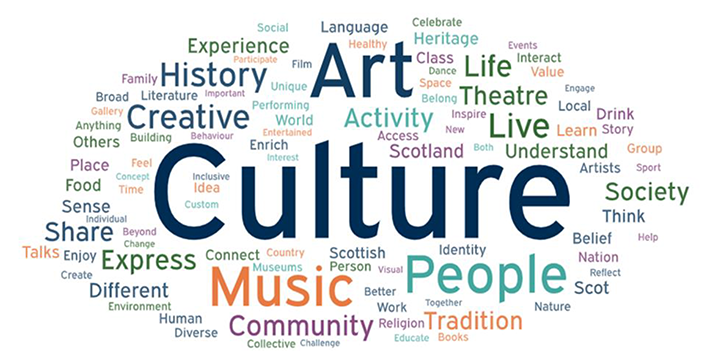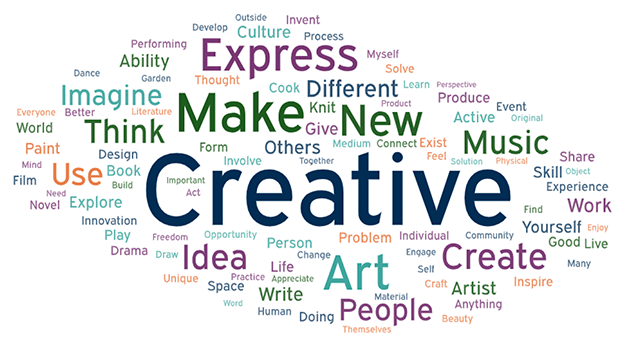Cultural engagement in Scotland: what is it and why does it matter?
This report provides evidence on cultural engagement in Scotland from 2019 - 2024. It draws on a range of data, from both the Scottish Household Survey and qualitative research, to explore attitudes and behaviours for different people and places across Scotland.
What does cultural engagement mean to people and how do they experience it?
Free-text survey – Qualitative research
An online free-text survey was launched on 8th July 2024 for 4 weeks. The aim of this research was to gather direct accounts from the public on their perspectives and experiences of culture and creativity, to supplement and update what we know from the SHS.
As the questions were all open, they were not based on any predetermined assumptions about what places or activities may be associated with culture or creativity. The survey was publicly available on the Scottish Government website and it was promoted by the Scottish Government ‘X’ (formerly Twitter) account. A link to the survey was also shared via a range of 40 organisations in the third and public sector to promote amongst their networks and members. Questions included ‘What does the term culture mean to you’ ‘How does taking part in cultural activities make you feel’ and ‘Does anything stop you from doing the things you would like to do if you have any free-time?’ See Annex H for the full list of questions and for the method.
The main limitation to this type of research is that the sample is self-selecting and not representative of the wider Scottish population. As it was opt-in it is likely that there was greater representation from people who may already have a higher level of interest and engagement in culture. Including, for example, people who work in the culture sector. Insights from this research are used to provide examples and illustrations from different perspectives, but they are not included to represent broader trends or insight that is generalized to any broader sub-populations.
Key points
Here is a summary of the main findings – the full report can be accessed on the Scottish Government website.
Who took part?
- 504 people completed this online ‘open text’ survey (see Annex H). Most (73%) respondents were female. There was a range of ages (ranging from under 18 to over 85 years) and representation from every Local Authority in Scotland. Over a quarter (27%) identified as having a long-standing physical or mental impairment, illness or disability.
What do culture and creativity mean to people?
- The variety of responses highlight the way that culture (Figure 11) and creativity (Figure 12) are a major part of people’s expression and identity, with a strong link to social connections and emotional wellbeing.
“It's going to concerts and festivals and revelling in everyone enjoying the same things. It's going to a regular pub quiz, it's music, it's in everything.” (Female, 25-34)
“It means the freedom to explore life, to take yourself out of the everyday grind, to gain a better understanding of world events through a multitude of lenses. It is an escape but also a tool to better understand myself my feelings, my actions.” (Female, age band not stated)


Importance and feelings around culture and creativity
- Respondents were unanimously positive about the role that culture and creativity play in their life. Reflecting on why this is the case, respondents' views centred around the following themes: opening doors, creating empathy, social connections and health and wellbeing benefits.
What do people like to do?
- When asked to describe what they like to do in their free time, the respondents to this survey provided a wide variety of answers. Some focused on specific activities, some described spending time interacting with people, or being in a certain place.
- Asking about ‘free time’ rather than culture specifically meant that respondents referred to both traditional cultural institutions such as museums and galleries and also more informal activities and places such as attending sporting events, crafts, online gaming, ceilidhs, or even going to the pub. This reflects the vision for culture in Scotland that recognises that cultural activity is expressed in a wide variety of ways.
How do people take part?
- Most respondents described doing a mixture of solitary and group activities, in-person and online. Some challenged the phrasing of ‘taking part’ in cultural activities, suggesting that culture is not something you have to go somewhere to do or access, it is part of everyday life.
“I also love community festivals and galas…I often have the most fun at these and love that I can meet so many of my friends and neighbours.” (Female, 45-54)
Barriers
- However, there are a range of factors that can impact on someone’s ability to do the things that they would like to do in their free time. This expands what we know from the SHS.[21] Respondents described issues relating to their personal perceptions and circumstances, accessibility issues, and wider social and structural issues that may limit opportunities available to them.
“For local events & socialising, the lack of late buses/trains to get home is limiting. Sometimes I'll pass-up an event because I'd have to leave so early to get public transport home that it's not worth going.” (Male, 65-74)
“I can't afford to go to the concerts / shows I'd love to see. The cost of living vs. my wages and the fact I have to support another person too, make it very hard to even manage to have food and pay the bills each month.” (Female, 35-44)
Place and space
- Respondents were asked what they think about the places and opportunities available to them, both locally and nationally. Respondents focused on the following themes: affordability, importance of free places, accessibility, the impact of reduced funding and missed opportunities.
“Many places are free, and I think that is an incredible thing that civic society offers” (Male, 45-54)
Summary
- This survey provided insight into the breadth and diversity of people’s experiences, and important detail on the specifics of people’s engagement that is not available in the SHS.
- For instance, how people like to engage, in what format, with whom, why they like certain events or places, and how major societal challenges such as the pandemic and the cost-of-living crisis have impacted on people’s attitudes and behaviours.
- This data helps us to understand in more detail why cultural engagement is uneven and the way that someone’s personal circumstances and preferences interact with the opportunities that are available to them locally.
- For example, cost and affordability were an issue for many people. This also interacts with issues such as opening times, the weather, the accessibility of places and venues, the frequency and reliability of public transport and having the time and energy to be able to engage in the first place.
Contact
Email: socialresearch@gov.scot
There is a problem
Thanks for your feedback